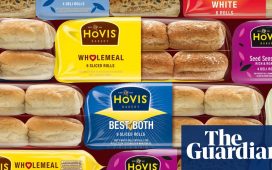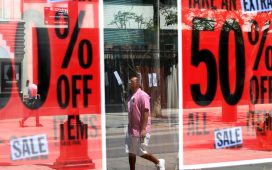Unlock the Editor’s Digest for free
Roula Khalaf, Editor of the FT, selects her favourite stories in this weekly newsletter.
The boss of J Sainsbury said shoppers were starting to splurge on certain items after two years of shopping for bargains, as Britain’s second-biggest supermarket forecast rising profits this year.
Asked how consumers were faring as the grocer reported annual results on Thursday, chief executive Simon Roberts said: “One of the first things we’ve seen in the first part of this year is less of an obvious trading down in the [shopping] basket, actually we’ve seen more evidence of customers starting to trade up a bit as well.”
This trend was “going to really start to build”, he added, following easing food price inflation, with customers “balancing their baskets more, not always trading down” and “looking for some of the other products we have available” such as its premium Taste the Difference range.
The shift marks a sign of a possible recovery in branded and higher-priced goods, after customers turned to supermarkets’ own-label ranges to keep food bills down during the cost of living squeeze.
UK grocery price inflation fell to a 30-month low in April, according to data that pointed to an easing of the cost of living crisis that has hit millions of households since late 2021.
Last month data from research group Kantar showed that sales of branded goods pushed ahead of own label in the four weeks to March 17, while premium own-label lines grew 16.1 per cent — the quickest rate in nearly three years.
Roberts added that a fall in interest rates could boost general merchandise and furniture sales in particular.
Sainsbury’s said it expected to deliver strong profit growth in 2024 despite a drop in earnings in the year just gone, as it seeks to lure more shoppers to its stores amid a fierce battle with rivals.
The grocer, which controls 15.3 per cent of the UK food market, is targeting underlying operating profits from its retail operations of up to £1.06bn in its current financial year, an increase of between 5 and 10 per cent year on year, having set out sweeping cost cuts in February of £1bn.
It posted a 6.8 per cent rise in retail sales, excluding fuel, to £30.6bn for the year to March 2.
Pre-tax profits fell 15.3 per cent to £277mn, largely related to its decision in January to withdraw from financial services and offload its core banking business to focus on retail. But underlying profits edged up 1.6 per cent to £701mn — at the top end of analysts’ consensus.
Sales of food were strong during the period although overall growth was damped by weak performance in general merchandise, clothing and fuel.
Like-for-like sales excluding fuel were up 7.5 per cent but growth decelerated from 9.8 per cent in the first quarter to 4.8 per cent in the last quarter. Total general merchandise sales fell 0.5 per cent, while clothing was down 6.4 per cent as some of its fashion ranges were not as popular with shoppers and it had some availability issues.
William Woods, a retail analyst at AllianceBernstein, said that “food inflation remains supportive and the food first strategy is working”, but the performance of the other divisions that include Argos and the Tu clothing brand was underwhelming.
Roberts said Sainsbury’s was the only traditional supermarket to meaningfully gain market share from discounters such as Aldi and Lidl as well as the more upmarket chains including Waitrose and Marks and Spencer.
The update comes after rival Tesco also forecast rising profits this month and said sales had been boosted by its premium range Finest, with chief executive Ken Murphy pointing to an “improvement in customer sentiment” amid easing inflation.








